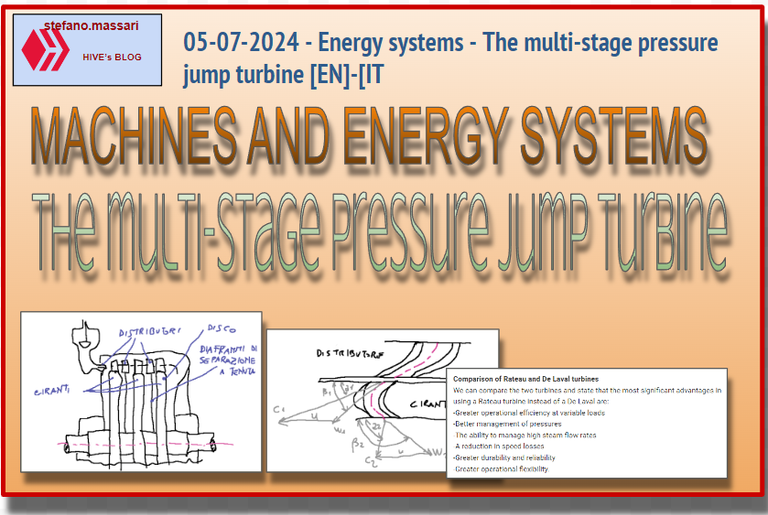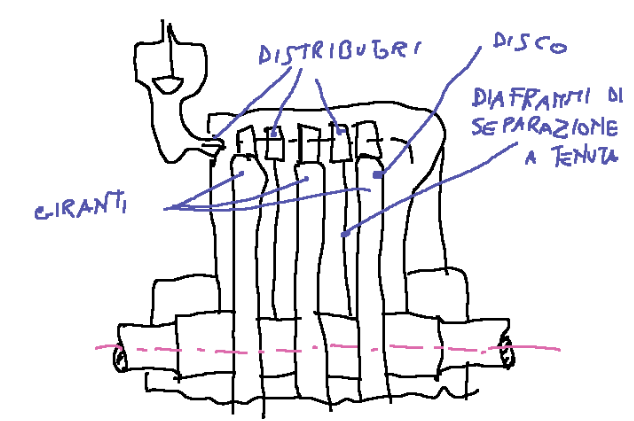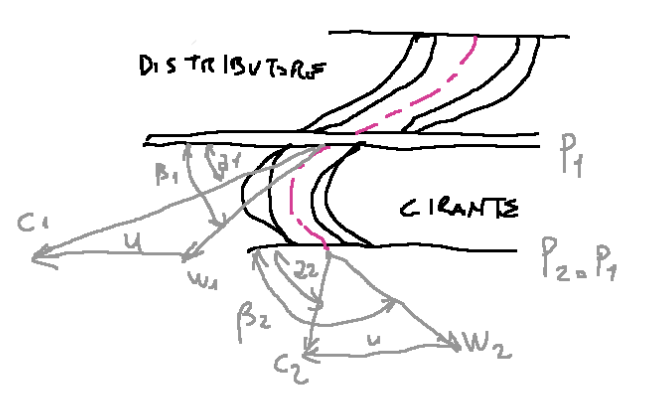05-07-2024 - Energy systems - The multi-stage pressure jump turbine [EN]-[IT

~~~ La versione in italiano inizia subito dopo la versione in inglese ~~~
ENGLISH
ITALIAN
05-07-2024 - Energy systems - The multi-stage pressure jump turbine [EN]-[IT]
The multi-stage pressure jump turbine
Rateau turbines
Rateau turbines are multi-stage pressure jump turbines where the pressure energy is processed by each stage.
Basically, in the Rateau turbine there is a decrease in pressure going from one stage to the next.
Below is a sketch of a Rateau turbine:

In Rateau turbines each stage is composed of a crown of stator blades followed by an impeller. The crown of stator blades is the distributor.
In the sketch above we see separation diaphragms.
The separation diaphragms between one impeller and the other serve to guarantee resistance to the drop in pressure that occurs in the distributors.
Note: Rateau turbines have been widely used in power plants for electricity generation
How it works
-High pressure steam enters the turbine
-In the first stages the steam undergoes a partial expansion, increasing its speed.
-Steam passes through the rotors. The high-velocity steam passes through the rotors, i.e. the moving blades. Here, the kinetic energy of the steam is converted into mechanical work, causing the rotors to rotate.
-The process of expansion and extraction of energy is repeated in several subsequent stages.
-After passing through all stages, the spent steam is discharged at a much lower pressure.
Speed Triangles
The speed triangles of a multi-stage axial pressure jump turbine are shown below

Comparison of Rateau and De Laval turbines
We can compare the two turbines and state that the most significant advantages in using a Rateau turbine instead of a De Laval are:
-Greater operational efficiency at variable loads
-Better management of pressures
-The ability to manage high steam flow rates
-A reduction in speed losses
-Greater durability and reliability
-Greater operational flexibility.
Conclusions
In conclusion we can say that the Rateau turbine is particularly suitable for large energy generation plants.
Request
Have you ever heard of the Rateau turbine before? Have you ever heard of the engineer Auguste Rateau?

ITALIAN
05-07-2024 - Sistemi energetici - La turbina ad azione pluristadio a salti di pressione [EN]-[IT]
La turbina ad azione pluristadio a salti di pressione
Turbine Rateau
Le turbine Rateau sono turbine ad azione pluristadio a salti di pressione dove l’energia di pressione viene elaborata da ogni stadio.
Sostanzialmente nella turbina Rateau si assiste ad una diminuzione della pressione passando da uno stadio al successivo.
Qui di seguito uno schizzo di una turbina Rateau:

Nelle turbine Rateau ogni stadio è composto da una corona di pale statoriche seguita da una girante. La corona di pale statoriche è il distributore.
Nello schizzo riportato qui sopra vediamo dei diaframmi di separazione.
I diaframmi di separazione tra una girante e l’altra servono a garantire la tenuta all’abbassamento di pressione che si realizza nei distributori.
Nota: Le turbine Rateau sono state ampiamente utilizzate nelle centrali elettriche per la generazione di elettricità
Il funzionamento
-Il vapore ad alta pressione entra nella turbina
-Nei primi stadi il vapore subisce una parziale espansione aumentando la sua velocità.
-Il vapore attraversa i rotori. Il vapore ad alta velocità passa nei rotori, ovvero le palettature mobili. Qui, l'energia cinetica del vapore viene convertita in lavoro meccanico, facendo ruotare i rotori.
-Il processo di espansione ed estrazione dell'energia si ripete in più stadi successivi.
-Dopo aver attraversato tutti gli stadi, il vapore esaurito viene scaricato a una pressione molto più bassa.
Triangoli delle velocità
Qui di seguito sono rappresentati i triangoli delle velocità di una turbina assiale pluristadio a salti di pressione

Confronto turbine Rateau e De Laval
Possiamo confrontare le due turbine e affermare che i vantaggi più significativi nell’usare una turbina Rateau anziché una De Laval sono:
-Una maggior efficienza operativa a carichi variabili
-Una migliore gestione delle pressioni
-La capacità di gestire elevate portate di vapore
-Una riduzione delle perdite di velocità
-Una maggiore durata e affidabilità
-Una maggiore flessibilità operativa.
Conclusioni
In conclusione possiamo dire che la turbina Rateau è particolarmente adatta per grandi impianti di generazione di energia.
Domanda
Avevate mai sentito parlare prima della turbina Rateau? Avete mai sentito parlare dell'ingegnere Auguste Rateau?
THE END
The Rateau turbine sounds incredible for energy plants. Its efficiency and reliability really stand out. Never knew about Auguste Rateau before though. Always learning something new from you brother
The diagram was quite difficult for me to understand but I’m glad I could do it
Nice topic!
Congratulations @stefano.massari! You received a personal badge!
You can view your badges on your board and compare yourself to others in the Ranking
Check out our last posts:
This is a very interesting topic and I love how the diagram explained it better
Good job!
Another great explanation! I like the effort that you make doing the diagrams hehehe